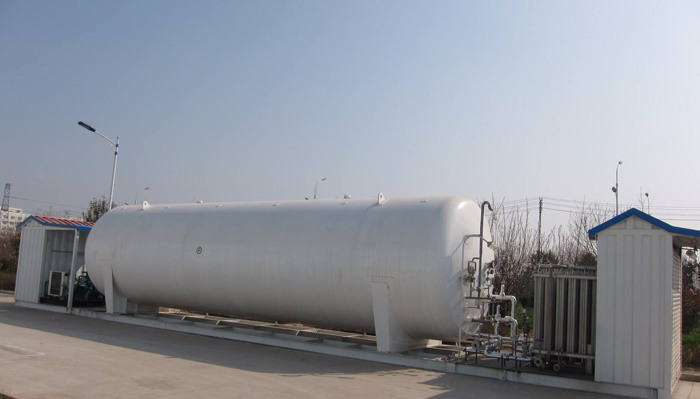Product Category
How to deal with the problem of high pressure in cryogenic tank
Date: Nov 18, 2019

Vertical or horizontal double-layer vacuum insulation tanks for storing liquid oxygen, nitrogen, argon, carbon dioxide, liquid natural gas media, we call them cryogenic storage tanks or cryogenic pressure vessel tanks, and cryogenic storage tanks are usually made of inner tanks and The outer tank is constructed with an insulating material in the middle.
When the cryogenic tank is planned, because the low-temperature medium in the tank has a conductive effect, the foundation soil is prone to freeze up and the soil is bulged, thereby forming a root damage, in order to eliminate this unfavorable factor, except for the surface of the tank bottom and the bottom and bottom plates. In addition to the insulation method, the anti-freezing method should be adopted for the bottom of the tank. There are two general methods. One is to make a slab-type base with a circulating heating system, and the other is to use an overhead bottom plate and overhead. The air layer separates the base plate from the foundation soil. The problem that cryogenic storage tanks may often present is that the pressure is too high. The vacuum and spread of the equipment itself and the improper use of cryogenic storage tanks can create excessive pressure in the cryogenic tank.
The problem that cryogenic storage tanks may often present is that the pressure is too high. The vacuum and spread of the equipment itself and the improper use of cryogenic storage tanks can create excessive pressure in the cryogenic tank.
The planning and manufacture of cryogenic liquid storage tanks can be viewed in three ways: Planning for internal and external bile structures to reduce conduction. The sandwich is evacuated to reduce convection. The interlayer is filled with insulation to reduce radiation.
Before filling the object, the low temperature tank should first check whether the outer casing is recessed or not, and whether the vacuum exhaust port is intact. If it is damaged, the degree of vacuum will drop. In severe cases, the intake air will not be insulated, so that the upper part of the tank will be frosted, the liquid loss will be large, and the value of continued use will be lost. Secondly, look inside the tank. If there is any foreign matter, it is necessary to take it out to prevent the inner tank from being corroded.
When the cryogenic tank is planned, because the low-temperature medium in the tank has a conductive effect, the foundation soil is prone to freeze up and the soil is bulged, thereby forming a root damage, in order to eliminate this unfavorable factor, except for the surface of the tank bottom and the bottom and bottom plates. In addition to the insulation method, the anti-freezing method should be adopted for the bottom of the tank. There are two general methods. One is to make a slab-type base with a circulating heating system, and the other is to use an overhead bottom plate and overhead. The air layer separates the base plate from the foundation soil.

The planning and manufacture of cryogenic liquid storage tanks can be viewed in three ways: Planning for internal and external bile structures to reduce conduction. The sandwich is evacuated to reduce convection. The interlayer is filled with insulation to reduce radiation.
Before filling the object, the low temperature tank should first check whether the outer casing is recessed or not, and whether the vacuum exhaust port is intact. If it is damaged, the degree of vacuum will drop. In severe cases, the intake air will not be insulated, so that the upper part of the tank will be frosted, the liquid loss will be large, and the value of continued use will be lost. Secondly, look inside the tank. If there is any foreign matter, it is necessary to take it out to prevent the inner tank from being corroded.
Last article:
Next article:
Send Your Inquiry
We not only provide a good product, but also provide high quality service. If you are interested in our products,
you can contact us in the following ways.
you can contact us in the following ways.







